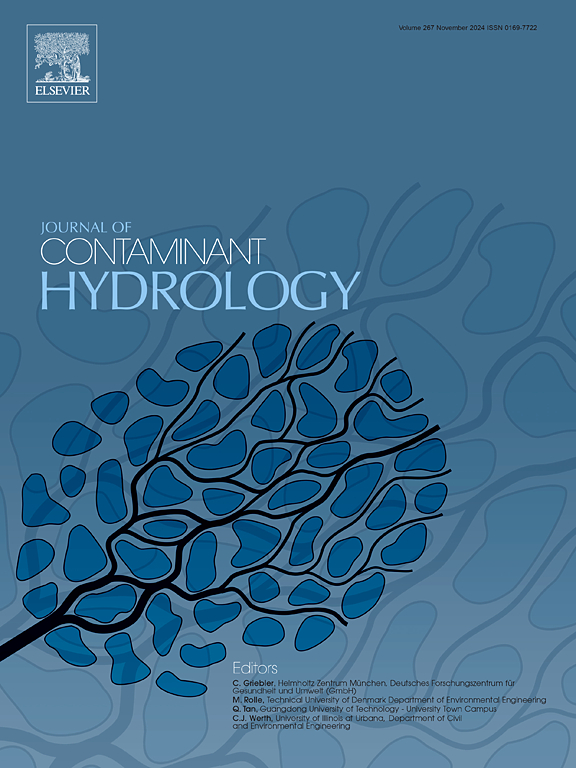中国北方大型不对称汇流区分层对水动力和混合过程的影响
IF 3.5
3区 环境科学与生态学
Q2 ENVIRONMENTAL SCIENCES
引用次数: 0
摘要
河流汇流区的水动力通常由周围地貌的几何形态、汇流河道的动量和流量比以及河床的形态特征决定。近年来研究发现,温度、盐度、含沙量差异引起的分层效应也会对汇流区下游水动力产生显著影响。本文采用三维数值模型研究了泥沙浓度分层对黄河-汾河汇合区流体动力学和污染物混合的影响。分析了深度平均场和二次流的分布。结果表明,泥沙浓度引起的密度变化对汇流区的横向和纵向流动动力学都有影响。这些变化包括流量大小、剪切层、低速区、横截面涡和二次流。当干流含沙量较大时,出现了明显的分层现象,支流污染物在运移和混合过程中在干流上方漂移。在这种条件下,污染物的混合过程加快,导致混合距离缩短。这种加速可归因于分层效应导致的截面二次流加剧。本研究的结果增强了我们对河流汇流区污染物混合模式的认识。本文章由计算机程序翻译,如有差异,请以英文原文为准。
Effects of stratification on hydrodynamics and mixing process at a large asymmetric confluence in northern China
The hydrodynamics in the confluence area of rivers are typically governed by the geometrical configuration of the surrounding landforms, the momentum and discharge ratios of the converging watercourses, and the morphological features of the riverbed. Recently, it has been discovered that stratification effects resulting from disparities in temperature, salinity, sediment concentration can also have significant impact on the downstream hydrodynamics of the confluence area. In this study, the impact of stratification induced by sediment concentration on fluid dynamics and pollutant mixing in the Yellow - Fen River confluence area is studied by using a 3D numerical model. The distribution of the depth-averaged field and secondary flow are analyzed. The findings revealed that the alterations in density caused by sediment concentration had effect on the flow dynamics across both horizontal and vertical dimensions of the confluence area. These alterations encompassed flow magnitude, shear layer, low velocity zone, cross-section vortex, and secondary flow. When the sediment concentration in the main stream was high, a noticeable stratification phenomenon emerged, whereby the tributary pollutants rode above the main stream during transport and mixing. Under these conditions, the pollutant mixing process accelerated, resulting in a shortened mixing distance. This acceleration can be attributed to the intensified secondary flow in the cross-section, brought about by the stratification effect. The findings from this study enhance our understanding of pollutant mixing patterns in river confluence areas.
求助全文
通过发布文献求助,成功后即可免费获取论文全文。
去求助
来源期刊

Journal of contaminant hydrology
环境科学-地球科学综合
CiteScore
6.80
自引率
2.80%
发文量
129
审稿时长
68 days
期刊介绍:
The Journal of Contaminant Hydrology is an international journal publishing scientific articles pertaining to the contamination of subsurface water resources. Emphasis is placed on investigations of the physical, chemical, and biological processes influencing the behavior and fate of organic and inorganic contaminants in the unsaturated (vadose) and saturated (groundwater) zones, as well as at groundwater-surface water interfaces. The ecological impacts of contaminants transported both from and to aquifers are of interest. Articles on contamination of surface water only, without a link to groundwater, are out of the scope. Broad latitude is allowed in identifying contaminants of interest, and include legacy and emerging pollutants, nutrients, nanoparticles, pathogenic microorganisms (e.g., bacteria, viruses, protozoa), microplastics, and various constituents associated with energy production (e.g., methane, carbon dioxide, hydrogen sulfide).
The journal''s scope embraces a wide range of topics including: experimental investigations of contaminant sorption, diffusion, transformation, volatilization and transport in the surface and subsurface; characterization of soil and aquifer properties only as they influence contaminant behavior; development and testing of mathematical models of contaminant behaviour; innovative techniques for restoration of contaminated sites; development of new tools or techniques for monitoring the extent of soil and groundwater contamination; transformation of contaminants in the hyporheic zone; effects of contaminants traversing the hyporheic zone on surface water and groundwater ecosystems; subsurface carbon sequestration and/or turnover; and migration of fluids associated with energy production into groundwater.
 求助内容:
求助内容: 应助结果提醒方式:
应助结果提醒方式:


